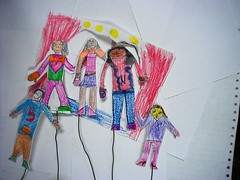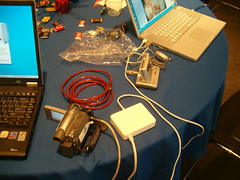It also meant that I was able to make a list of things that, once I eventually taught elementary, would be able to drill into my students to prevent premature baldness and graying amongst the high school art teachers.
This list included the following five things:
 People are not sticks. (I don't mind if a 3rd grader tries to draw a person and it doesn't turn out, but a 3rd grader drawing a stick figure isn't even trying.)
People are not sticks. (I don't mind if a 3rd grader tries to draw a person and it doesn't turn out, but a 3rd grader drawing a stick figure isn't even trying.)- Trees are not lollipops.
- Not every tree has to have a hole in the trunk. (Honestly, half of them draw the holes so they're wider than the trunks!)
- I've never seen a blue cloud in a white sky.
- Sky touches ground. (A blue bar at the top is ... a blue bar at the top. Not a sky.)
Granted, I didn't cover these things in every grade and every lesson. Not all students are developmentally able to comprehend my little list, and I still have room in my curriculum to do lessons that are more fun than they are nitpicky.
But at least by the time they leave elementary school all of my students know:

- A way to draw people that have at least enough mass to wear some clothes.
- A way to draw trees that are more accurate depictions than a circle (or green cloud) on a stick.
- That because it can exist on one thing does not mean it exists on everything.
- More than one way to make cool looking skies , including sunsets, storm clouds, and more.
- What a horizon line is.
My official curriculum is much more detailed than this, but I suppose these items are my "pet peeves," if you will.
And this sort of got me thinking: Since I might become a technology teacher in a couple years, how will my list change? What are my technology pet peeves that I'll feel I must cover, above and beyond the official standards?
I came up with something like this:

- Be safe! There are ways to be safe from online predators, stalkers, identity thieves, cyberbullies, and so on. Use them.
- Be creative! The great thing about the internet is that anyone can create content, including you!
- Be skeptical! The bad thing about the internet is that anyone can create content, including people who mislead others. Take the things you see online with a grain of salt.
- Be cautious! Also, what happens on the internet stays on the internet, but not in a good way. Anything digital can be copied and archived, as well as indexed for easy searching. Don't put it online unless you want your mom, teacher, principal, significant others, and any future bosses to see it.
- Be clear! There media (PowerPoint, website, movie, etc.) should never be more important than the message it's used to convey. Overworked and poorly designed projects can both keep people from remembering the very things you wanted them to learn.
Well, that's my list, at least. What's yours?
9 comments:
O boy.. found this site on plurk.. I had to.. had to.. reply when i saw your 5 learner outcomes. I'm no teacher sir.. a psych grad though but I'd like to throw my two cents in... drat i hate to use cliche'.. anyway...
stick figures.. I don't think thats lazy I mean who says art is supposed to be work anyway? At least if its someone who doesn't plan to use it that way. Second.. I don't know any lazy 3 year old's maybe bored, maybe , stick figures probably just make sense they cover the basic idea of the body, usually have most of the parts of the body, at least the ones that mean something to the kids.. In my opinion if they are drawing stick figures it is because they see the important functions of the body as being able to grab, kick, run and play, not look any particular way. Their flexibility may be another reason. To them a stick figure can do anything a human can do.. just as much as a doll, gumby, or dragon. A stick figure is like a place holder for them I would guess. Now as we get older i would say we misplace some of that flexibility and expect realism.
The clouds in the sky, If the paper is white, and you know their are 2 colors to a normal sky, then well, blue is the way to go :) at least they are putting colors that make sense together. I bet.. if you gave them blue paper.. they would color with white crowns :) Not to say that your not doing a damn good job in making them think by asking them about the clouds.. and maybe challenging their designs.. I'm not protesting just looking at it a bit differently. Maybe the sky isn't important in what they are trying to portray in their picture... maybe they are just looking for something to take up space at the top... sure their art may not make sense to us.. but that doesn't mean it doesn't make sense to them.. and i mean really how different from that pile of garbage in the middle of an art museum that no one understands are the kids drawings? Hard to understand without asking the artist, ridiculous in nature, and the conclusions they expect you to reach totaly unrealistic.
I wouldn't call you nitpicky.. not at all but me being a psych grad .. the first thing I want to do is get the kids interpretation of the drawing.. that interests me more then all the doodles in the world.
Cheers!
p.s Sorry about the spelling, I'm poor at it :)
I think you may have misunderstood the age group where I start expecting certain criteria from my students. If I see a 3 year old draw a stick figure I'll be giving him or her high praise.
At very young ages they're experiencing things for the first time, still learning the basics of hand-eye coordination, and the like. My contention is that once they've reached 6th grade they should at least KNOW these things, whether or not they choose to use them in their artwork.
Art is very much about inspiration and creativity, but at the same time it's also about observing and knowing the world around you. I have plenty of lessons where creativity is the main goal, but I would be remiss in my duties if I didn't also cover realism to some (age appropriate) degree.
Trust me on this friend. I have no experience with art teaching or any manner .. and I must have misunderstood the age group. I though you were talking about three year olds :) omg i reread it *slaps head* haha... even so had it been three year olds I wasn't disagreeing so much as just thinking aloud. I hope i didn't sound like a jerk.. just trying to start a conversation :)
Not a problem! I'm a big fan of online conversations, and I've been in your shoes more than once over the years. :)
On the unofficial tech standards I would add:
BE BRAVE!
Since I teach middle schoolers, I see them not wanting to try something they don't think they will be good at. I am a teacher half of the time and a cheerleader the other half. All students need to be risk-takers to be the progressive leaders in technology.
Glad you understand. I need to learn to read all those little details.. I so often read books .. or well.. pretty much everything .. for the big picture points.. I have very little attention for any detail that doesn't cut straight to the heart of a author or artist's major idea... but sometimes they slip their idea into the cracks... and then i have to go back and reread because i get a feeling i missed something. Unfortunate when a point I missed is the crux of my conversation hahah
"I’ve never seen a blue cloud in a white sky "
- just saw nearly a whole class of Year2s (3rd Grade) do exactly this yesterday. Just after they were told specifically not to do that. Go figure!
I think I had you as a teacher back in 2001-2002 at Chopticon High School. I might be wrong, and if so, ignore this. Only, I don't remember these lessons, in any way, shape or form. But, being the child of two high-school teachers myself, I have to agree that, only in extenuating circumstances, there is no reason for such lack of effort. I mean, maybe it's just me, but I don't understand how or why most people are unable to do their stinkin' job in school and earn praiseworthy grades and find a particular skill in which the learner enjoys. It may be a lack of effort in pushing the kids to their potential, but I get the distinct impression that most parents just don't know what their own kid is capable of anymore and therefore thinks that pushing them is a losing battle.
You're right, I used to be your teacher. I remember you using a M:tG card as a straightedge for one of my lessons, but let's not get too off topic for now. :)
And no, you wouldn't remember those lessons - that was only my second year as a full time teacher and, frankly, I was still forming my ideas back then. A lot of what I'd been taught about teaching in college didn't work, so I was starting from scratch.
I see your point of view - there are some people who just write kids (and teachers) off as "lost causes" for one reason or another. At the same time, however, many of us have so many requirements heaped upon us (*cough*NLCB*cough*) that we have to pick our battles carefully. In my case art often fell by the wayside since the popular opinion is that the "core" subjects are more important.
Do many just give up? Yes.
Could parent involvement with encouraging children make up for what schools don't have the time or resources for? Of course.
Alas, not every administrator is going to value a well rounded art (or "insert special interest that encourages young minds here") program, and not every parent is going to have the time, energy, and motivation to encourage their kids.
Here's hoping that most of the next generation has at least one of those two scenarios going well for them.
Post a Comment